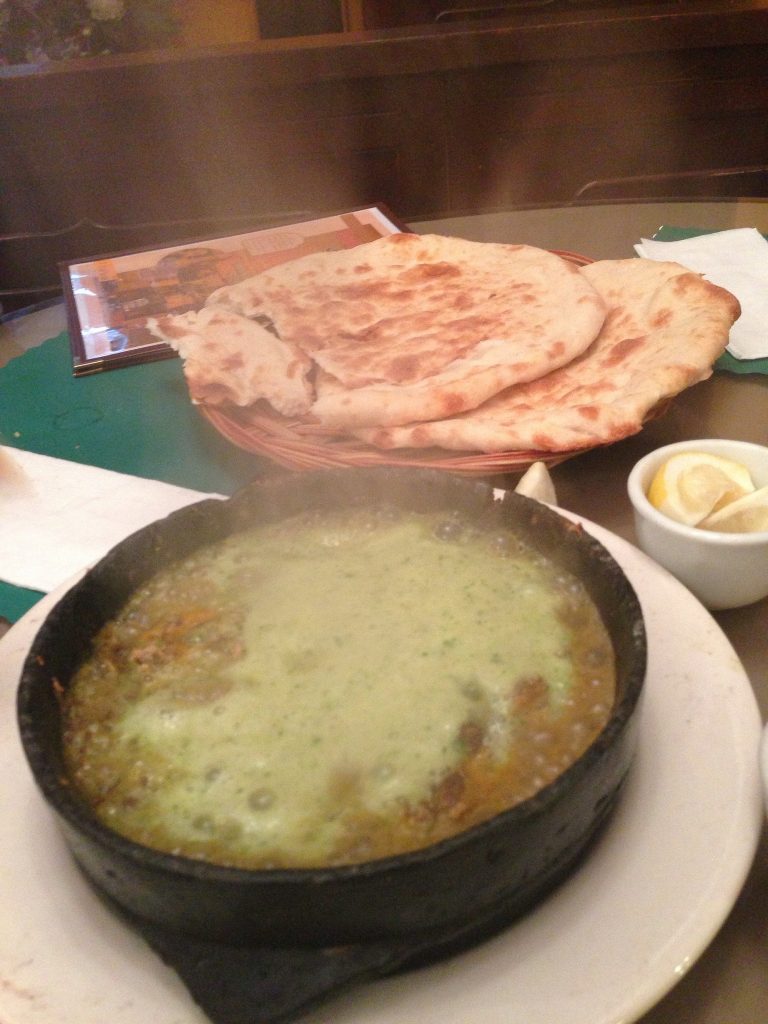saltah سَلْتَة: Yemen’s National Dish Posted by Ibnulyemen اِبْنُ اليَمَن on Apr 30, 2017 in Culture, Vocabulary
Bint aS-SaHn بِنْت الصَّحْن , sousi سُوْسِي , shafout شَفُوْت, and saltah سَلْتَة are some delicious Arabic dishes that are peculiar to Yemen. While the others are popular on special days and occasions, سَلْتَة is eaten every day and by far the most favorite; ergo, it is Yemen’s National Dish.
Linguistically, what is the origin of the word saltah سَلْتَة ?
The very word saltah سَلْتَة is derived from the Arabic root salata سَلَتَ ‘to eat and lick eagerly.’ By way of derivation in Arabic, we say سَلَتَ , يَسْلِتُ, سَلْتًا and the food ‘being carefully extracted from the boiling hot pot and eagerly eaten and licked’ is سَلْتَة. This means that having this dish involves a lot of ‘eager licking’ particularly since it is typically eaten while it is still boiling; besides, it is ensured that boiling and high heat stay for as long as possible. This is the reason why it is served in a pot of clay or stone which is called Hardhah حَرَضَة or maqlaa مَقْلَى. The حَرَضَة tends to be smaller than مَقْلَى. Although modern thick steel pots are lately used, locally-made حَرَضَة and مَقْلى are always preferred. Therefore, سَلْتَة that is not served in a حَرَضَة is not really سَلْتَة by traditional Yemeni food standards.
Yummy, for those who have eaten سَلْتَة! So, what are the ingredients and how is سَلْتَة prepared?
Typically, سَلْتَة is almost a vegie dish. Its basic ingredients are حُلْبَة ‘fenugreek’, مَرَق concentrated consommé soup, بَطَاطَا potatoes, بَيْضَة an egg, بِسْبَاس green chili pepper, كُرَّاث or بَيْعَة (in Yemeni dialect) ‘leek’, ثُوْم ‘garlic’, طَمَاطِم ‘tomatoes’, and مِلْح ‘salt’. People add other spices based on their taste. Prior to the actual making of سَلْتَة, three mixtures are to be prepared separately.
- The mixture of حُلْبَة and كُرَّاث:
Two to three spoons of طَحِين الحُلْبَة ‘fenugreek flour’ is to be sprinkled in water and left for two to three hours. Then, the water is to be fully dribbled. The حُلْبَة is to be beaten by hand till it turns white (up to 5 minutes of vigorous stirring, quite an exercise (but worth it 😊). The كُرَّاث is to be cut and pounded manually till it becomes juicy. It then is added to the paste of حُلْبَة and mixed thoroughly.
- The mixture of سَحَاوِق:
سَحَاوق, derived from the verb سَحَقَ ‘to grind’ is a sauce-like blend of tomatoes, garlic, green chili, and a dash of salt. Traditionally, this mixture is squashed manually on a flat stone called مَسْحَقَة ‘a flat stone with a small round stone on which spices and vegies are grounded.’ Grinding using مَسْحَقَة is always tastier than the one ground in a blender.
- The mixture of مَرَق:
مَرَق is a thick stock of seasoned meat, especially beef. Little fatty meat with bones is boiled for almost two hours. Seasonings بُهَارَات, like فِلْفِل أَسْوَد ‘black pepper,’ and كَمُّون مَطْحُون ‘cumin powder’ are added to the stock. Also, adding chopped بَصْل أَخَضَر ‘scallion’ makes the مَرَق tastier and thicker.
What’s next …
The حَرَضَة is placed over a fierce flame and is left for 2 to 4 minutes until it gets extremely hot. Then, the مَرَق is thrown into the حَرَضَة. Chopped slices of بَطَاطَا, بَيْضَة, and فِلْفِل أَخْضَر are added. This is accompanied by very quick stirring, mixing, and adding of مَرَق as needed to prevent the mixture from burning or sticking. The حَرَضَة is left on fire for two to three minutes. Then, the حُلْبَة mixture is added to the top without mixing it. Voila! سَلْتَة is ready to be eaten and is served immediately. As for the سَحَاوق, a little bit of it may be poured with حُلْبَة; alternatively, most people leave it as a side dish and added according to taste. So, how’s this eaten? سَلْتَة is eaten with خُبْز ‘bread,’ خُبْز قَمْح ‘wheat bread’, خُبْز شَعِير ‘barley bread,’ كِدَم, or جَحِين ‘ both local multi-grained bread’ popular in the northern regions of Yemen.
This is how سَلْتَة is traditionally made. However, more recently, protein-rich variants of سَلْتَة have been introduced, especially in restaurants. One variant is called فَحْسَة; it is derived from the Arabic root فَحَسَ ‘to mash.’ Essentially, the meat, which the مَرَق is made from, is mashed fully and added to the سَلْتَة mixture. Another variant is سَلْتَة with تُوْنَة ‘tuna.’ Simply, a can of تُوْنَة is thrown into the mixture. The latter variant is not as popular as the former two.
One reason why سَلْتَة is exceedingly popular is that it is associated with Chewing Qat (more on this soon). Qat chewers, almost 90% of Yemenis, particularly men, believe that a session of Qat Chewing will not be as enjoyable and relaxing if they did not have spicy سَلْتَة for lunch. Besides, سَلْتَة is cheap and easy to prepare. مَرْق is replaced with vegie stock spiced with a cube of Maggi or a teaspoon of MSG.
Now, let’s learn more of Arabic Cuisine.
Using Google or YouTube
a) Try to get acquainted with the three other Yemeni dishes mentioned above.
b) Find out what the National Dishes for Kuwait, Egypt, Mauritania, and Jordan are.

Build vocabulary, practice pronunciation, and more with Transparent Language Online. Available anytime, anywhere, on any device.




